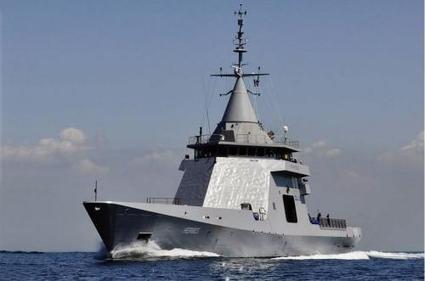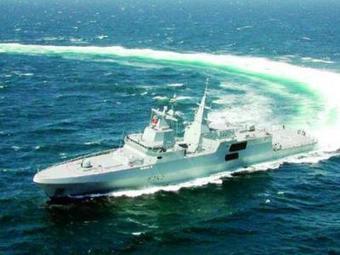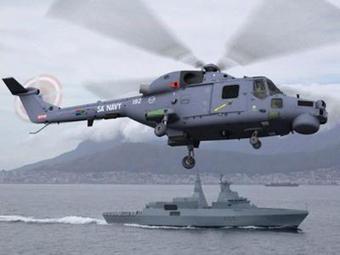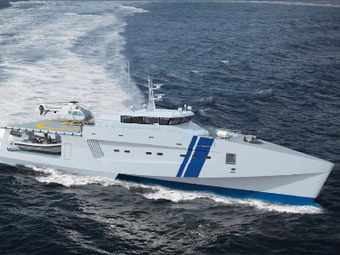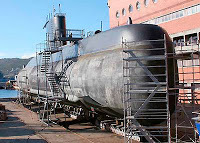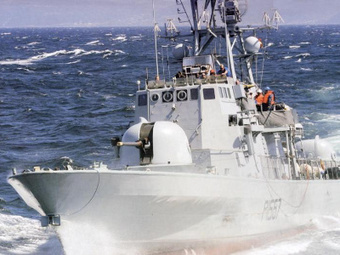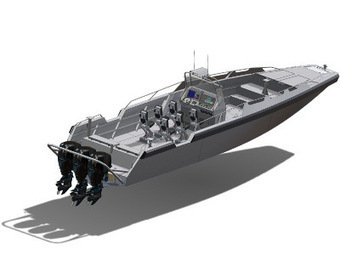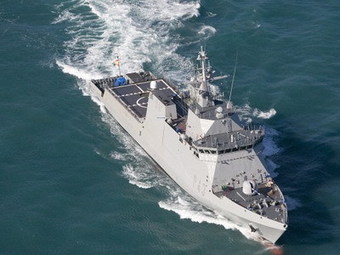 Your new post is loading...

|
Scooped by
Patrick H.
|
The South African arms procurement agency Armscor issued two separate requests for proposals (RfPs) on 3 December for three 'multimission' offshore patrol vessels (OPVs) and three 'multimission' inshore patrol vessels (IPVs). Both tenders close on 30 June 2015. The OPV will have a waterline length of about 85 m, a beam of about 4 m, a displacement of around 2,000 tonnes, a speed of 20 kt, a range of 6,000 n miles and an endurance of 21 days. The RfP also says the ship should be able to operate away from base for at least 90 days and be capable of spending 270 days at sea each year.

|
Scooped by
Patrick H.
|
The second of the Navvy’s Heroine class submarines, SAS Charlotte Maxeke, will not undergo a refit in the immediate future because the Request for Offer (RfO) was withdrawn by Armscor.
At the same time the Navy, though its public relations officer, Captain (SAN) Zamo Sithole, said the “refit is scheduled to commence once requisite funding has been identified”.
Charlotte Maxeke was commissioned on March 14, 2007, with the pennant number S102. Her sister underwater craft are SAS Manthatisi (S101) and SAS Queen Modjadji 1 (S103).
According to Armscor’s operational purchases tender system, Tender ARMD/10/14 for the refit of SA Navy submarine S102 at the Armscor Dockyard in Simon’s town has been withdrawn. The state security acquisition agency’s manager: corporate communication, Barileng Dichabe, said the RfO was not cancelled but withdrawn. “It was issued as a single source to the original equipment manufacturer (Howaldtserke, Deutsche Werft in Kiel),” she said.
Asked what effect the delay in refitting the second of the Type 209 submarines acquired by the maritime arm of the SA National Defence Force (SANDF) as part of the Strategic Defence Procurement Packages (SDPP) would have on the Navy’s underwater capability, Sithole said “to all intents and purposes the Navy will continue to have two submarines in the operational cycle at any time”. He explained: “The SA Navy normally has one submarine in refit and two submarines in the operational cycle, with phases of maintenance, training and operational availability.
“Owing to SAS Charlotte Maxeke preparing to go into refit and SAS Manthatisi completing harbour acceptance trials (HATS) this can be construed as the SA Navy having only one submarine (SAS Queen Modjadji 1) currently in the operational cycle. However as the refit of SAS Charlotte Maxeke has yet to commence, she can still be considered to be in the operational cycle and can still be put to sea following some minor work and training, if required.”
The refit, including a complete battery replacement, of SAS Manthatisi, has been underway since 2007. She was originally targeted to start HATS in May but this was delayed due to problems with supply of certain spare and replacement parts.
“Sea acceptance trials will only commence once the Navy is satisfied all HATS have been completed to rigorous Navy safety standards,” Commander Greyling van den Berg said in June.
“No hard and fast date has been set for her re-commissioning. The date will be determined by progress of the harbour acceptance trials.”
The Navy previously pointed out the re-commissioning of SAS Manthatisi was the first time this has been done to a Type 209 submarine in the Simon’s town dockyard and the experience gained would be put to good use on the other two Heroine class underwater craft.
According to Sithole the Navy “is still intent” on the Charlotte Maxeke refit.
“It will be done as soon as possible and the refit will be completed within the planned timescales. No changes are foreseen to the Navy business plan for its submarines,” he said.

|
Scooped by
Patrick H.
|
04/02/2014 (Infodefensa.com) G. Soriano, Madrid - Navantia want to offer in the coming months to South Africa several patrol ships and boats, and the design of a survey vessel. A South African delegation, which eventually led unable to be as planned by its defense minister, Navantia visit this morning, two months before the expected start of the largest of these programs. The Spanish company plans to qualify for the South African naval procurement program BIRO , which includes commissioned three ocean patrol vessels ( OPV , for its acronym in English), three coastal patrol ( IPV ) and twelve boats. The Spanish naval company estimates that the South African authorities issued its request for proposal ( RFP ) to shipyards shortlisted next April. The supply of vessels that Navantia expected to opt BIRO program is based on your family Avante , consisting of surveillance and patrol vessels ranging from 45 meters in length and 295 tonnes displacement model Avante 300 , to 98.9 meters and 2,500 tons of Avante 2200 Combatant . Then, about three months after BIRO program, called program will likely launch HOTEL , which includes the design of a hydrographic vessel which also provides opt Navantia.
Visit of the Minister of Defence This morning visit of a delegation from Navantia African country led by its ambassador to Spain, Fikile Magubane , accompanied by the Chief of Staff of the Navy ( AJEMA ), Admiral Jaime Muñoz-Delgado . The South African Minister of Defence, N. Nosiviwe Mapisa-Nqakula , who is visiting in Spain, has finally been able to attend this meeting, apparently by an indisposition, according to company sources. Minister Mapisa-Nqakula itself was released yesterday facilities Airbus Defence and Space in Sevilla and Indra in Madrid, accompanied by Secretary of State for Defence ( SEDEF ), Pedro Argüelles . Minister's agenda includes a meeting with the Defense Minister Peter Morenés at the headquarters of the Ministry . Navantia sources point out that South Africa has never been a customer of its products, but the company has always chosen to their offerings. In the '90s, for example, the Spanish firm participated in the process of choosing a program of corvettes was finally canceled the abolition of Apartheid , as the country chose to use the money for other purposes. The program recovered a few years later, but did not finally Navantia with the construction of these vessels

|
Scooped by
Patrick H.
|
... Remis à la Marine nationale en novembre 2011, L’Adroit, qui a été admis au service actif en mars 2012, quittera en effet la flotte française dans un peu plus d’un an. Il n’a, en effet, pas vocation à être acheté par la marine, qui en est certes satisfaite, mais doit atteindre la prochaine loi de programmation militaire (2020 – 2024) pour espérer voir la commande de ses patrouilleurs de nouvelle génération, les BATSIMAR...
...DCNS doit donc trouver un client export pour reprendre son bateau. En l’espèce, plusieurs prospects seraient intéressés, notamment en Amérique latine (on parle de l’Uruguay), mais aussi en Afrique. Dans ces deux régions, les besoins en moyens de surveillance et de contrôle des zones maritimes sont en effet très importants, notamment dans le cadre de la protection des installations offshore et des réserves halieutiques, ainsi que la lutte contre les trafics illicites....
Lire l'intégralité de l'article sur Mer et Marine : http://www.meretmarine.com/fr/content/dcns-cherche-vendre-ladroit

|
Scooped by
Patrick H.
|
The South African Navy is being crippled by a lack of qualified personnel, which means that only half its frigates and one of its three submarines can be manned at any one time.
According to a well-placed source in the South African defence environment, only one of the three submarines can go to sea as the South African Navy (SAN) has enough personnel to man one at a time. Further compounding this is the fact that the Navy’s submarine fleet spends two thirds of its time in the dockyard.
The submarine SAS Manthatisi is still in the dock as she undergoes maintenance related to electrical systems – the batteries were damaged in 2007 when a sailor plugged in an incorrect electrical system. According to the source, the entire electronics of the submarine were damaged when this occurred. A new battery was ordered but Manthatisi’s refit will only be completed in July next year, leaving SAS Queen Modjaji and SAS Charlotte Maxeke operationally available.
However, top South African defence analyst Helmoed Romer Heitman told defenceWeb that the Manthatisi’s batteries were not destroyed and they are being replaced because they are at the end of their lives. “The one mistake there was was saving money by buying batteries from a company outside Germany, which did cause some problems,” he said. Experiences with gas buildup in the batteries has caused some issues.
“The Navy had planned to run the three 209s the way they had run the three Daphnes: one fully operational; one in commission and operational but used mainly for training and alternating with the operational boat for minor maintenance; and the third in reserve pending refit timed to bring it back into service as another approaches its refit date,” Heitman said.
“On that basis they trained up two crews and drove 101 [SAS Manthatisi] and 102 [SAS Charlotte Maxeke] hard during their warranty periods – to make sure that any faults surfaced while the Germans would still have to pay for them; then when 103 [SAS Queen Modjadji] was available, they docked 101 and used the crew to fetch 103 and drive that hard during the warranty period. The Navy then went over to rotating 102 and 103 as the two operational boats, and 101 is now in refit and will take the place of the one of the other two with the most sea time, which will then go into refit.
“Meanwhile the Navy has found that the new technologies in these boats make it possible to keep two fully operational at all times, not rotating as planned, and intend to move to that. But that will require two crews plus about half a crew to allow for training, work on the third boat, etc. That is one part of the problem. The other is…the drain of qualified people – operational and technical – and a reluctance of many people…to serve in boats.”
On the frigate side, there are only enough personnel to operate two of the four frigates at a time, the source told defenceWeb. Having been in service for eight years, they are due for a mid-life upgrade. The frigates have suffered engine problems due to a design shortcoming of the engines, which are not suited to local sea conditions.
However, Heitman said the engine problems are not a result of the engine’s design but the result of having too few technical staff and, more importantly, too few with experience. “So procedures were not always followed and warning alarms not always heeded; add the lack of time for maintenance and the lack of funds for spares and you are on the slippery slope to nowhere…” Lire l'intégralité de l'article : http://www.defenceweb.co.za/index.php?option=com_content&view=article&id=31410:sa-navy-crippled-by-lack-of-qualified-personnel&catid=108:maritime-security&Itemid=233

|
Scooped by
Patrick H.
|
The South African Navy will continue anti-piracy patrols in the Mozambique Channel until at least the end of March next year.
This is in terms of an edict issued by South African National Defence Force (SANDF) commander-in-chief, President Jacob Zuma. The announcement was made this week in terms of section 201(2) (c) of the Constitution.
South Africa’s involvement in anti-piracy operations off the east coast of the continent was formalised by a Memorandum of Understanding (MOU) entered into with Mozambique and Tanzania. The MOU is part of the Southern African Development Community’s contribution to end piracy off the East African coast.
This has seen the maritime arm of the SANDF as the main contributor to anti-piracy patrols in the Mozambique Channel with support from the SA Air Force and the SA Army, based at Pemba. The airborne elements involved have centred round the ageing C-47TP maritime patrol aircraft and the single-engined Cessna 208 Caravan. Land-based forces have supported the Navy’s Maritime Reaction Squadron in boarding and search operations of ships classified as “suspicious”.
The Presidency indicated 220 South African Navy sailors, supported by various SA Air Force musterings and elements of the SA Army have been active in Operation Copper between November last year and the end of March this year.
While the anti-piracy tasking is normally assigned to one of the Navy’s Valour Class frigates, this has not always been possible due to non-availability of ships. The fleet replenishment ship, SAS Drakensberg, has completed two tours of duty in the Channel.
She is, to date, the only SA Navy vessel to have been part of a successful patrol sortie. This saw her take on the stopper role to prevent a pirate vessel sailing south to escape an EU Navfor patrol further up the east coast.
In just on three years of deployment in this tasking only one death has been recorded.
Last may Maritime Reaction Squadron member, Able Seaman Thulani Mbuli, drowned during a boarding sortie of a suspected pirate dhow.
SAS Amatola is currently on station on the Channel. While the main tasking of the ship and her crew is anti-piracy interdiction this has not stopped her from assisting seafarers in distress.
Last month Amatola was on the receiving end of a distress call from the Panamanian vessel, MV Meem, at anchor in Nacala Bay. Amatola responded and urgent medical treatment was given to three crew members infected with malaria.

|
Scooped by
Patrick H.
|
The South African Navy has commenced its first major force preparation exercise of 2013, which is taking place from 4 to 15 March around Cape Town.
Held annually, Exercise Red Lion is run by Fleet Command and concentrates its efforts on preparing all available vessels for future Force Employment as a Task Group.
According to the Navy, the exercise aims to tests the abilities of the Task Group to maintain a persistent presence at sea, including patrols, surveillance and the conduct of Maritime Interdiction Operations.
The main objectives of Exercise Red Lion 2013 are to:
• Improve multi-ship interoperability
• Improve inter-ship communications
• Exercise surface and subsurface interaction
The exercise will require the Navy to provide Force Protection capability whilst alongside and at anchor, as well as to conduct ad-hoc taskings in support of the “people and other government departments.” The latter includes salvage diving operations on SELI 1 (on request by Cape Town Harbour) and Operation Beachy, co-ordinated by the Cape Town Disaster Risk Management Centre.
Vessels participating in the exercise include the frigate SAS Spioenkop, the off-shore patrol vessel SAS Isaac Dyobha, the two minehunters SAS Umhloti and SAS Umzimkulu as well as the submarine SAS Charlotte Maxeke.
In addition to the warships, embedded Maritime Reaction Squadron members will provide capabilities such as Sea Boarding and Force Protection.
South African Air Force aircraft will also be participating in the sea phase, contributing C-130BZ Hercules transports, Oryx and Super Lynx helicopters.
The Task Group Commander is Captain DR Faure, who will be based onboard SAS Spioenkop during the exercise and will rove amongst participating entities as required.
The first phase, between 4 and 10 March, involves detailed planning and onshore training and safety exercises. Practical drills include search and rescue exercise conducted by SAS Umhloti off Cape Point and a basic harbour fire exercise.
The second phase, to take place on Tuesday 12 March, involves Operation Beachy off Mouille Point, whereby SAS Spioenkop will simulate a cruise ship. With NSRI participation, Operation Beachy is the third in a series of exercises dealing with various hazards in the City of Cape Town and the aim is to expose all the role-players to as realistic scenario as possible whereby their response and recovery actions and inter-service co-operation and integration can be assessed.
SAS Spioenkop will then transit to Saldanha Bay for the final phase of the exercise. More exercises, such as periscope, vertical replenishment at sea, towing exercises, prowling exercise and gunnery exercises are scheduled in and around the Saldanha Bay area.

|
Scooped by
Patrick H.
|
On December 3rd, 2012, Kommer Damen, President of Damen Shipyards Group, officially opened the new, multifunctional building of Damen Shipyards Cape Town (DSCT).
|

|
Scooped by
Patrick H.
|
SAS Manthatisi (S 101), the first of three Type 209 submarines acquired by the South African Navy as part of the 1999 Strategic Defence Procurement Package, has re-entered service after a major refit and is participating in the biannual Exercise 'Ibsamar IV' in Cape waters with the Brazilian and Indian navies. Commissioned in November 2005, the submarine has been subject to much speculation and disinformation since it was withdrawn from service in 2007. Its withdrawal after less than two years prompted criticism from some commentators that South Africa had wasted its money on a non-operational submarine. However, the move was in line with the South African Navy's intention to operate two of the three submarines at any one time and keep one in reserve: the same operational cycle used with the Daphné-class submarines that the Type 209s replaced.

|
Scooped by
Patrick H.
|
Denel Dynamics plans to extend its UAV family with the addition of a rotary wing capability for the South African National Defence Force (SANDF), company officials have disclosed. Speaking to Shephard at the Defence Services Asia (DSA) exhibition in Kuala Lumpur, Denel executive manager Sihle Mayisela said the development was in the ‘very early stages’. The company’s current inventory of unmanned systems includes the fixed-wing and tactical Seeker 200 and 400 platforms as well as the Hungwe. However, Mayisela said the introduction of a VTOL capability would be much more relevant to maritime requirements. Denel has teamed up with South Africa’s Council for Scientific and Industrial Research (CSIR) institute to design a VTOL concept which, Mayisela said, would initially comprise a smaller platform similar in size to Schiebel’s Camcopter. However, current market trends are seeing European and US efforts to design larger rotary wing UAV/OPV platforms for cargo resupply taskings as well as maritime surveillance. ‘The VTOL requirement is for the SANDF and this trend is seeing everyone going that way. We can’t afford to be held back,’ Mayisela continued. Denel said it would be relying on experience accrued with its Rooivalk attack helicopter programme, with Mayisela adding: ‘We are taking this technology and technology from our UAVs to do something very similar.’ Elsewhere, the company is planning tests to extend the capability of its fixed-wing UAVs operating in the maritime environment. Currently, none of Denel’s UAV solutions can be launched from a vessel. However, the company is looking to conduct tests to launch a UAV from land before handing control over to a maritime platform. According to Mayisela, initial tests will be conducted later this year with the SANDF, although the capability will remain restricted to line of sight operations. Furthermore, he said Denel was not currently considering launching its fixed-wing platforms from ships.

|
Scooped by
Patrick H.
|
South Africa's Paramout Group has announced it is to add another acquisition to its portfolio as it looks to branch into the maritime sector, fulfilling a long-standing ambition to acquire a shipbuilder. Paramount will take a 51% ownership stake in Cape Town-based Nautic Africa for an undisclosed sum. James Fisher, the current CEO and owner, will hold the remaining 49%. Paramount CEO John Craig told IHS Jane's that Nautic's "burgeoning order book" and a "pressing operational need for maritime capability" in Africa and elsewhere made the company an attractive target. Indeed, Craig estimates the acquisition will add between 10-15% to Paramount revenues. (Source : IHS Jane's) Paramount Naval Systems (previously Nautic Africa) has announced the development of a new 42 metre aluminium trimaran patrol vessel.
The announcement was made at the Thursday ceremony in Cape Town where Paramount Group, Africa’s largest privately owned defence and aerospace company, formally publicised their acquisition of a majority stake in Cape Town-based ship building company Nautic Africa. The military business side of Nautic Africa has been rebranded as Paramount Naval Systems.
Speaking at the ceremony, CEO James Fisher noted that the new 42 m trimaran patrol vessel is the “first fruit of the association” between Paramount Group and Nautic Africa. It will also be the first time that a vessel of this nature is being designed and built in South Africa.
To be known as the Frontier Patrol Vessel, Fisher said that the trimaran is being developed in direct response to an obvious need in the market for a highly efficient, sea-kindly, multi-role platform.
Supporting the initiative, Ivor Ichikowitz, Executive Chairman of Paramount Group, said: “We are committed to the development of the South African shipbuilding industry and putting Africans at the heart of it.”
Nautic Africa has a legacy of only using locally designed vessels to keep the intellectual capital in South Africa.
Emphasising the importance of the project, Ichikowitz said that the project would be internally funded. “We consider (the new design) to be very strategic,” he said, “Not only to be proof of concept, but also to do effective trials.”
Michael Bakker, naval architect and head of product development, explained that the trimaran offers improved propulsive efficiency and better economy over a wider speed range when compared to the equivalent monohull.
“At the same time,” Bakker continued, “it will provide a more stable work platform as it has superb stability with respect to seakeeping.”
Building of what Fisher describes as “a cutting edge design” will commence in 2014. Able to sustain itself for long durations at sea, the design features a helideck, space for two interceptor boats and a crew of 30. The top speed of 29 knots is capable of being increased to 40 knots when larger engines, of which there are two, are specified.
Both Ichikowitz and Fisher stressed that the new design is a way for smaller defence forces to have a patrol capability at a cheaper cost. With an increasing threat facing Africa from the sea in the form of piracy, theft of marine resources and drug trafficking, Fisher noted that “there has never been a greater need for naval security in the waters around Africa.”
As a result, there is a demand to have more vessels on the water. A capable vessel with a low purchase and support cost, Fisher said, can result in more vessels for a smaller budget.

|
Scooped by
Patrick H.
|
The planned refit, including battery replacement, of SAS Manthatisi, the first of the SA Navy’s (SAN) Heroine Class submarines, is expected to be completed by the end of next month.
S101 has been out of service since 2007 following what was then reported to Parliament as damage to the boat’s electrical systems when “someone” connected the submarine to its high voltage shore service “the wrong way round” blowing fuses.
SAN Fleet public relations officer, Commander Cara Pratten, said it was planned for Manthatisi to be back in the water by March next year for first harbour and then sea trials.
“Indications are she will be fully operational by September next year.”
All the work associated with the refit and replacement of defective and/or damaged parts is being done in the Simon’s town dockyard, run by Armscor.
The battery replacement will see Manthatisi get 480 new man-sized cells weighing 250 tons. Former SAN chief director: maritime strategy Rear Admiral Bernhard Teuteberg told a 2010 Parliamentary briefing the battery replacement would cost in the region of R35 million. He said at the time the overhaul was “major”.
The refit and overhaul work currently nearing completion on Manthatisi is in accordance with the laid down schedules for the Type 209 diesel electric submarine as well as being in line with the SAN’s business plan for its underwater craft.
This sees one operational, one on standby and available for training while the third undergoes maintenance.
Manthatisi is the lead boat of the Heroine Class acquired at a cost of more than R8 billion as Project Wills, a component of the controversial Strategic Defence Procurement Packages (SDPP). This multi-billion Rand acquisition of new front-line equipment for the SA Air Force and SAN is currently the subject of hearing by the Seriti Commission.
The other Heroine Class boats are the SAS Charlotte Maxeke and SAS Queen Modjadji.
Last August Modjadji hit the ocean floor while on a training exercise between Port Elizabeth and Durban but did not suffer any damage.
A SAN statement issued then said the boat suffered a minor collision to her forward section while on routine patrol along the east coast. The high pressure oil supply was briefly interrupted resulting in a temporary loss of control.
“The boat collided with the ocean floor but immediately surfaced,” the statement said.
On her return to Simon’s town Modjadji was inspected by a team of divers and a hull survey was done showing no damage to the pressure hull structure.

|
Scooped by
Patrick H.
|
The three upgraded Warrior-class strike craft that were converted into offshore patrol vessels have almost completed sea trials prior to acceptance by the South African Navy, with trials due for completion by the end of the month.
At the end of February this year, SAS Isaac Dyboha (P1565) completed its SATS (Sea Acceptance Trials), according to Southern African Shipyards, which refurbished the vessels. SAS Galeshewe (P1567) has completed HATS (Harbour Acceptance Trials) and is scheduled to undergo SATS by the end of this week. SAS Makhanda (P1569), which had to be towed to Durban, is currently undergoing pre-HATS and is expected to have completed SATS by the end of May.
It was revealed last year that the Navy was keen to retain three Warrior-class (ex-Minister-class) strike craft as offshore patrol vessels (OPV), of nine originally received in the in the 1970s and 1980s. The first vessel, SAS Isaac Dyobha, arrived in Durban in October last year. The next vessel to undergo refurbishment was SAS Makhanda, which left Simon’s Town under tow on November 3. SAS Galeshewe arrived in Durban in mid-December, having just completed a patrol off the east coast.
According to Southern African Shipyards, a range of work was done on all three vessels, which can be broken down into electrical and mechanical. The electrical part included the replacing of alternators, air circuit breakers and engine monitoring systems. The company repaired cabling and serviced the switchboards. On the mechanical side, storage tank and hulls were inspected and corroded areas and all doublers were replaced with inserts.
“At the end of the programme the Navy will have three serviceable reliable vessels that it will be able to use effectively for the next five years,” said Lucinda Creamer, Southern African Shipyards PRO/Marketing Officer.
A fourth fast attack craft has been towed to Durban, but as the tender for its refurbishment has not yet been awarded, it is not with Southern African Shipyards. The stripped hull of SAS Adam Kok (P1563) left Simon’s Town for Durban on May 8, under tow by the hydrographic and oceanographic research vessel SAS Protea.
The South African strike craft were fitted with6-8 Gabriel Mk II surface-to-surface missiles, known locally as the Scorpion, and two Oto Melara 76 mm guns. Secondary armament comprised two 20 mm Oerlikon cannons and two 12.7 mm machineguns.
The 58-metre long strike craft displace 415 tons, or 450 tons fully loaded. Four MTU diesel engines developing 12 000 hp give a speed of at least 34 knots (60 km/h) and a range of around 4 800 nautical miles (8 900 km) at 19 knots (35 km/h).
Since the commissioning of the four Valour-class frigates in 2004/5, strike-craft have been used in the OPV role. Late last year, Rear Admiral (JG) Bravo Mhlana, South African Navy Director Force Preparation, told defenceWeb that “what we are building with those patrol vessels is for the future acquisition of offshore patrol vessels under Project Biro. That is why we must keep those vessels as long as we can when we can transfer crews from those to the new patrol vessels.”

|
Scooped by
Patrick H.
|
KND has ordered nine boats from Veecraft Marine, which will deliver the vessels in April this year. This contract is a collaroration between KND, Veecraft and the Namibian Navy.
The nine vessels range between ten and 14 metres in length and include an eleven metre landing craft.
Andre van Niekerk, Managing Director of Veecraft Marine, told defenceWeb that the project started last year and involved collaboration with naval architects Kobus Naval Design (KND). “KND brings us orders and we give them the design,” van Niekerk said. KND has signed a contract to deliver 20 boats to the Namibian Navy, with production already underway.
van Niekerk said that Veecraft specialises in the construction of vessels for the oil and gas industry as well as the military, offering a range of eight to 45 metre long patrol boats, interceptors, tug boats, work boats and harbour vessels.
Veecraft has done work for the South African Navy, such as delivering five riverine patrol boats for the Marines. These 12 metre boats are powered by inboard diesel engines driving Hamilton water jets and have room for six special forces personnel. This project was completed in 2010.
Veecraft is also involved in Project Carol, the acquisition and procurement of small boats for the South African Navy. This initiative is at the initial stages and involves a variety of vessels below 60 metres in length.
In February last year it was announced that Navantia had signed a Memorandum of Understanding with Veecraft to market Navantia’s Avante class offshore and inshore patrol vessels to the South African Navy as part of Project Biro.
Although Veecraft is based in South Africa, Van Niekerk said his company looks purely at the export market, notably Africa and the Middle East. He said that wherever there is oil and gas, there is insecurity and piracy and hence a need for patrol boats, protected supply boats, interceptors and other similar craft. For instance, Veecraft is currently manufacturing two 20 metre boats for Nigeria. These feature safe rooms or ‘citadels’ to protect their crew in case of attack. Although piracy around the world has dropped recently, van Niekerk said that with oil the way it is, the industry is in fact stronger than ever.

|
Scooped by
Patrick H.
|
The Spanish Offshore Patrol Vessel ESPS Relámpagois paying an informal visit to Cape Town over the period 19 to 22 December.
The South African Navy says that the objective of the visit is to enhance and strengthen contact between the Spanish Navy and the local South African community as well as to maintain the SA Navy’s international relations with the Spanish Navy.
Of course, it is no secret that Navantia, designers and builders of the Relámpago, is seeking to take part in the South African Navy’s Project Biro competition for new offshore (OPV) and inshore (IPV) patrol vessels.
Navantia said that the ship can be adapted to the requirements of the South African Navy. “This OPV is a medium sized, multipurpose and high performance ship with great versatility regarding missions (and) has low acquisition and life cycle costs,” a Navantia spokesperson explained... ...A request for information for the OPV/IPV-category vessels to be acquired under Project Biro was issued last year. The SA Navy expects to issue a request for quotations before the end of this year.
South Africa plans to build the new OPV/IPV vessels locally in order to strengthen local industry and ensure self-reliance. Many of the world’s leading shipyards are expected to submit tenders, with many having already entered into partnerships with local South African shipyards.
Prior to her arrival in South Africa, the Relámpago participated in Operation Atalanta, the European Union Naval Force’s counter-piracy operation off the Somali coast. She made a name for herself when, on 8 September, she rescued 68 people after finding them adrift in a small boat in the middle of the Gulf of Aden.
|



 Your new post is loading...
Your new post is loading...





